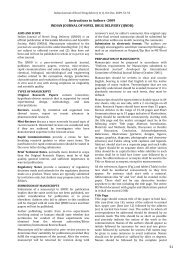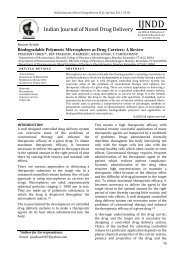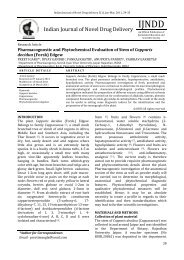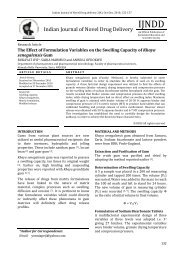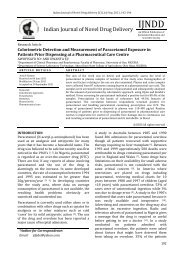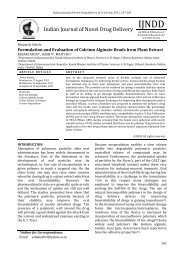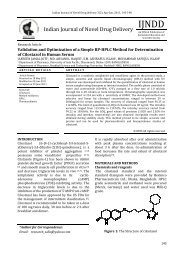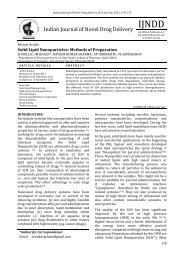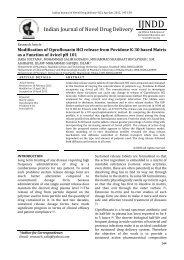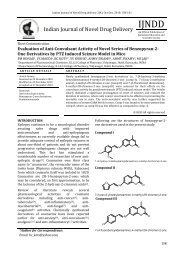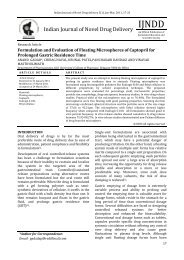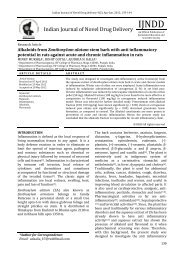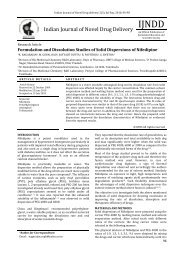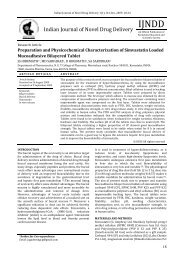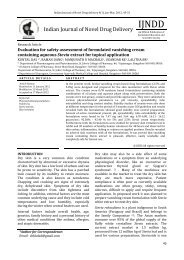Mucoadhesive Polymers - Indian Journal of Novel Drug Delivery
Mucoadhesive Polymers - Indian Journal of Novel Drug Delivery
Mucoadhesive Polymers - Indian Journal of Novel Drug Delivery
You also want an ePaper? Increase the reach of your titles
YUMPU automatically turns print PDFs into web optimized ePapers that Google loves.
Swamy NGN et al / <strong>Indian</strong> <strong>Journal</strong> <strong>of</strong> <strong>Novel</strong> <strong>Drug</strong> <strong>Delivery</strong> 4(1), Jan-Mar, 2012, 2-16<br />
transport <strong>of</strong> hydrophilic mannitol [76]. To<br />
improve the poor water solubility <strong>of</strong> chitosan,<br />
some derivatives have been synthesized, such as<br />
trimethylchitosan [77, 78] and polyethylene glycol<br />
(PEG)-chitosan [79] . Thanou et al. have reported<br />
that the trimethyl chitosan was soluble and<br />
effective in enhancing intranasal absorption even<br />
at neutral pH [77]. It was reported that 5-<br />
methylpyrrolidinone chitosan [80], thiolated<br />
chitosan [81], and N-trimethyl chitosan<br />
hydrochloride [82] are more mucoadhesive<br />
compared to unmodified chitosans and show a<br />
higher bioavailability in vivo in comparison to<br />
unmodified chitosans.<br />
Mei et al. have reported that the permeationenhancing<br />
effect <strong>of</strong> chitosan increased with<br />
increasing MW up to 100 kDa [83] . Study by<br />
Tengamnuay et al. have revealed chitosans<br />
should differ in their MW by at least two folds in<br />
order to have a clearly differentiating effect on<br />
the nasal absorption enhancement <strong>of</strong> a<br />
kyotorphin analogue [84] . On the contrary, Zaki et<br />
al. found out that there is no significant<br />
difference between the constants <strong>of</strong> intranasal<br />
absorption for metoclopramide HCl administered<br />
with chitosan high weight (600 kDa) and low<br />
weight (150 kDa) even though they differ in MW<br />
by four fold [85] . The same result was obtained in a<br />
study by Aspden et al. [86] .<br />
Because <strong>of</strong> the positive charge <strong>of</strong> chitosan in a<br />
weakly acidic environment, it can also be utilized<br />
to deliver the negatively charged DNA through<br />
nasal mucosa and protect them from nuclease<br />
degradation [87] . Compared with viral vectors,<br />
this alternative vector markedly reduced the<br />
safety risks resulting in high transfectability [88] .<br />
Recently many studies have revealed that nasal<br />
immunization with chitosan plus an inactive<br />
vaccine is a potentially effective, easily<br />
administered form <strong>of</strong> vaccination. Bordetella<br />
pertussis filamentous hemagglutinin and<br />
recombinant pertussis toxin have shown to<br />
induce very strong systemic and mucosal<br />
immune reactions against the antigens when<br />
intranasally administrated with chitosan [89, 90] .<br />
Read et al. confirmed that the standard<br />
inactivated trivalent influenza vaccine<br />
administered intranasally in combination with<br />
chitosan glutamate (0.5%, w/w) could induce<br />
both systemic and local immune responses, and<br />
the results were not statistically different from<br />
those obtained following administration <strong>of</strong> the<br />
commercial influenza vaccine by the<br />
intramuscular route [91] . Bacon et al. [92] have<br />
reported that chitosan solutions are able to<br />
enhance both the mucosal and the systemic<br />
immune responses against influenza virus<br />
vaccines. Mice that received chitosan/vaccine<br />
formulation intranasally, revealed high IgA titers<br />
in nasally revealed washings but this was not<br />
observed in mice receiving the antigen through<br />
subcutaneous injection [92] .<br />
Other cationic macromolecular materials, such as<br />
poly-L-arginine and aminated gelatin have also<br />
been investigated for their application as nasal<br />
absorption enhancers [82,93]. These polymers<br />
work in a way similar to chitosan, at least in<br />
animal models, and have been found to be<br />
effective in enhancing the absorption <strong>of</strong><br />
fluorescein isothiocyanate (FITC)-dextran and<br />
insulin with only negligible nasal toxicity [93, 94] .<br />
CONCLUSION<br />
With advantages such as mucoadhesion, an<br />
increase in the residence time <strong>of</strong> the polymer,<br />
penetration enhancement, and enzymatic<br />
inhibition, mucoadhesive polymers will<br />
undoubtedly be utilized for the nasal delivery <strong>of</strong><br />
a wide variety <strong>of</strong> therapeutic compounds. This<br />
class <strong>of</strong> polymers has enormous potential for the<br />
delivery <strong>of</strong> therapeutic macromolecules, genes,<br />
and vaccines. Unfortunately, only a few studies<br />
have been conducted with new-generation<br />
mucoadhesive polymers for nasal drug delivery,<br />
and very few papers focus on the changes <strong>of</strong><br />
structure and rheology <strong>of</strong> the mucus caused by<br />
the mucoadhesive polymer, and as to what<br />
extent the interaction between the polymer and<br />
the mucus influences the release <strong>of</strong> the drugs<br />
including the diseased condition. With recent<br />
advancements in the fields <strong>of</strong> biotechnology and<br />
cytoadhesion, the authors believe that there will<br />
be both academic and industrial efforts to<br />
explore this new area <strong>of</strong> nasal drug delivery, and<br />
it might not be too far fetched to envisage more<br />
and more nasal products that employ<br />
mucoadhesive polymers.<br />
REFERENCES<br />
[1] Gavini E, Hegge AB, Rassu G, Sanna V, Testa<br />
C, Pirisino G, Karlsen J, Giunchedi P. Nasal<br />
administration <strong>of</strong> Carbamazepine using<br />
chitosan microspheres: In vitro/in vivo<br />
studies Int J Pharm. 2006;307(1): 9–15<br />
[2] Mainardes RM, Urban MC, Cinto PO, Chaud<br />
MV, Evangelista RC, Gremião MP.<br />
Liposomes and micro / nanoparticles as<br />
colloidal carriers for nasal drug delivery.<br />
Curr <strong>Drug</strong> Deliv. 2006; 3(3): 275-85.<br />
11



